ALMA’s time-lapse movie showing the “afterglow” of a powerful gamma-ray burst. These images of the millimeter-wavelength light reveal details about the energy in the GRB’s jets.
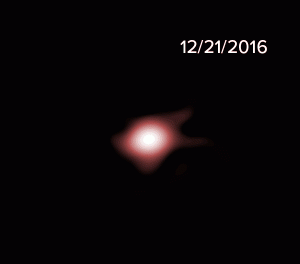
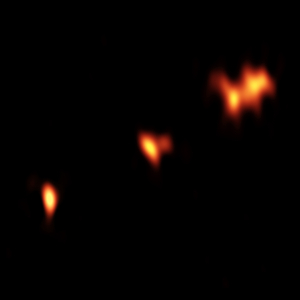
Distant Quasar Providing Clues to Early-Universe Conditions
VLBA image of the quasar P352–15, at a distance of nearly 13 billion light-years from Earth. Three main components of the object are seen, with two of them showing further substructure.
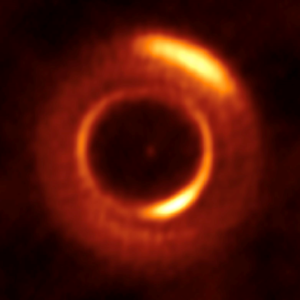
Spiral Arms and Dusty Clumps Seen in ‘Rare Breed’ of Protoplanetary Disk
Recent ALMA observations have reshaped our understanding of protoplanetary disks, the planet-forming regions around young stars. A striking new high-resolution image of MWC 758 — a young star about 500 light-years from Earth — reveal a dusty disk unlike any seen before. With its off-center cavity and sweeping spiral arms, MWC 758 may also provide new insights into the process of planet formation. “Our observations reveal a great amount of exciting new details in this system and provide crucial clues on their origins,” said Roubing Dong, a researcher with the University of Arizona and the Academia Sinica Institute of Astronomy and Astrophysics (ASIAA) in Taiwan.
The origin of these structures is in hot debate among astronomers. They may be the result of unseen planets forming in the disk or the large central cavities could be the outcome of radiation from the central star evaporating the inner disk.
Past observations of MWC 758 in 2012, as seen in reflected light, revealed a pair of near symmetric giant spiral arms. Earlier millimeter observations uncovered a big inner hole and two major dust clumps. The new ALMA image reveals that the previously known cavity of MWC 758 is off-center from the star and elliptical in shape. The millimeter dust emission feature corresponds nicely with one of the two spiral arms previously seen in reflected light. Both discoveries are the first among protoplanetary disks.
“MWC 758 is a rare breed!” says Sheng-Yuan Liu at ASIAA, “All major types of disk structures have been found in this system. It reveals to us one of the most comprehensive suites of evidence of planet formation in all protoplanetary disks.”
Photo Credit: ALMA (ESO/NAOJ/NRAO)/Dong et al.
Additional information
This research is presented in a paper “The Eccentric Cavity, Triple Rings, Two-Armed Spirals, and Double Clumps of the MWC 758 Disk” by Dong et al. to appear in the Astrophysical Journal.
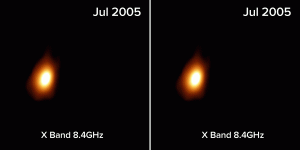
Astronomers See Distant Eruption as Black Hole Destroys Star
For the first time, astronomers have directly imaged the formation and expansion of a fast-moving jet of material ejected when the powerful gravity of a supermassive black hole ripped apart a star that wandered too close to the cosmic monster. This animated gif shows the expansion the of radio-emitting region where the star was shredded by the supermassive black hole. The expansion indicates a jet of particles moving outward.
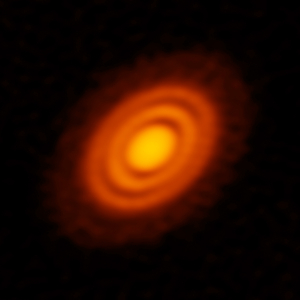
ALMA Finds Compelling Evidence for Pair of Infant Planets around Young Star
ALMA image of the protoplanetary disk surrounding the young star HD 163296 as seen in dust. New observations suggested that two planets, each about the size of Saturn, are in orbit around the star. These planets, which are not yet fully formed, revealed themselves by the dual imprint they left in both the dust and the gas portions of the star’s protoplanetary disk.

Glowing Core of Brilliant Galaxy NGC 5643
This composite image shows the center of a galaxy named NGC 5643. This galaxy is located 55 million light-years from Earth in the constellation of Lupus (The Wolf). It is one of a class of objects known as a Seyfert galaxy. Seyfert galaxies have very luminous centers — thought to be powered by material being accreted onto a supermassive black hole lurking within — that can also be shrouded and obscured by clouds of dust and intergalactic material.
As a result, it can be difficult to observe the active center of a Seyfert galaxy. NGC 5643 poses a further challenge; it is viewed at a high inclination, making it even trickier to view its inner workings. However, scientists have used the Atacama Large Millimeter/submillimeter Array (ALMA) together with archival data from the Multi Unit Spectroscopic Explorer (MUSE) instrument on ESO’s Very Large Telescope to reveal this view of NGC 5643 — complete with energetic outflowing ionized gas pouring out into space.
These impressive outflows stretch out on either side of the galaxy and are caused by matter being ejected from the accretion disk of the supermassive black hole at NGC 5643’s core. Combined, the ALMA and VLT data show the galaxy’s central region to have two distinct components: a spiraling, rotating disk (ALMA data shown in red) consisting of cold molecular gas traced by carbon monoxide, and the outflowing gas, traced by ionized oxygen and hydrogen (VLT data shown in blue-orange hues) perpendicular to the inner nuclear disk.





